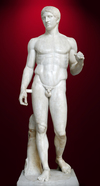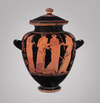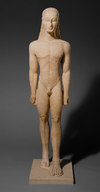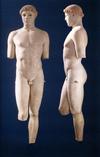Exam #2 Study guide Questions Flashcards
(67 cards)
Name the Greek and Roman Architectural orders.
- Doric
- Ionic
- Corinthian
- Tuscan
- Composite
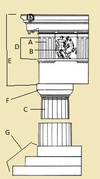
Doric order ~ 600 BCE
A) Triglyph
B) Metope
C) Fluted Shaft
D) Frieze
E) Entablature
F) Capital
G) No Base
*Has Pediment on Top Flat/Triangular

Ionic Order ~600 BCE
A) Entablature
B) Frieze with Relief
C) Capital with Volute Scrolls
D) Fluted Column/Shaft
E) Base
F) Pediment- Triangular uppermost portion

Corinthian Order ~450 BCE
A) Pediment
B) Entablature
C) Frieze
E) Fluted Column/Shaft
F) Base
*Top of column is capital with Acanthus leaves

Tuscan Order (Roman)
A) Unfluted Shaft (Wooden- Etruscans)
B) Base (unlike Doric)
C) Capital
D) Pediment
E) Frieze (continuous)
F) Entablature
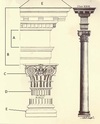
Composite Order (Roman)
A) Frieze (continuous)
B) Entablature
C) Ornate Capital
D) Fluted Column
E) Pediment
E) Base
Archaic Greek Sculpture
- c.600-480 BCE
- Egyptian-like style (standing pose, proportions)
- Life-sized Statues
- Kouros (young male; naked) (Funerary Statue)
- Kore (young female; clothed)
- figures were more stylized and less realistic than those of the Classical period
- Rigidly upright posture and tightly curled hair are characteristic of Archaic sculpture.
- Bulging Eyes
- Archaic Smile (forced smile)
- Examples; New York Kouros, Anavysos Kouros, Peplos Kore
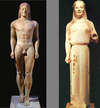
Transitional/Early Classic Greek Sculpture
- Classical sculptors such as Polykleitos strove to create a sense of life in their figures through the accurate depiction of posture and musculature; canon (body= x7 heads), believed in mathematical formulas for perfection.
- standards of harmony and proportion
- Transitional or Early Classic c.480-450 BCE
- “Severe style”- transition from the Archaic to the early Classical period. This style shows naturalism; more subdued and realistic departure from the Archaic. Subjects were on verge of emotional expression and poses that imply motion.
- Examples; Kritian Boy, Charioteer of Delphi

Classical Period (Middle Classic)
- c.450-400 BCE
- Polykleitos of Argos The Canon; relationship of parts to one another.
- basic unit of measure and ratio debated
- contrapposto, cross-balancing
- Example; Spear Bearer (Doryphoros) - Roman copy

contrapposto
an asymmetrical arrangement of the human figure in which the line of the arms and shoulders contrasts with while balancing those of the hips and legs.

Classical Period (Late Classic)
- c.400-320 BCE
- Contemplative expression
- Non-athletic activity
- More even weight distribution.
- Different set of proportions by Lysippos; More slender bodies than Polykleitos’ canon and head 1/8 of body size
- Example; The Scraper (Apoxyomenos) (Roman copy).

The Hellenistic Period
- 320- 30 BCE
- After the death of Alexander (323 BCE) the empire splits
- Three powers: Macedonia and Greece, Egypt and Asia Minor
- Pergamene style; greater naturalism and expressionism, Hellenistic sculptors placed more emphasis on motion and drama, exaggerating many Classical traits. Facial expressions and the folds of drapery are deeply carved, creating shadows
- Examples; Laocoon and His Sons, Nike (Victory) of Samothrace

What are some Great Feats of Engineering used by the Romans?
roads, sewers, and aqueducts.
Roman Roads
- Roman roads were straight and well made due to tool called groma; an instrument that had two pieces of wood nailed together to form a square cross with right-angles in all the corners. Each piece of wood had lead weights attached to the ends. When one lead weight from the same piece of wood lined up with the one in front of it, the surveyor knew that he had a straight line.
- Actual building done by Roman soldiers
- Roman roads were well used throughout the empire
- they lasted for centuries
- Had channels to prevent flooding

Roman Sewers
- The Romans built public and private toilets found all over the empire.
- toilets had well designed drainage systems to carry away the sewage.
- miles of sewers that carried the waste to the river Tiber where it flowed out to sea. (Cloaca Maxima.)
- recycled public bath water as part of the flow that flushed the latrines.
- Terra cotta piping was used in the plumbing that carried waste water from homes.

Roman Aqueducts
- The Romans constructed numerous aqueducts throughout the Empire
- Brought water into cities and towns— from distant sources.
- The water supplied public baths, latrines, fountains, and private households.
- Aqueducts moved water through gravity alone, usually along a slight overall downward gradient within conduits(channel for conveying water) of stone, brick, or concrete, but sometimes through steeper gradients
- Most conduits were buried beneath the ground and followed the contours of the terrain
- obstructing peaks were circumvented or, less often, tunneled through
- valleys or lowlands intervened, the conduit was carried on bridgework, or its contents fed into high-pressure lead, ceramic, or stone pipes and siphoned across
- included sedimentation tanks, which helped reduce any water-borne debris
- Most Roman aqueducts were flat-bottomed, arch-section conduits that ran 0.5 to 1 m beneath the ground surface
- Conduits above ground level were usually slab-topped, made of a series of round arches.

Explain intuitive perspective (a type of linear perspective used by the Romans).
- Romans used diagonal lines to give the illusion of a 3rd demention
- intuitive perspective. objects are placed at an angle to the picture plane, but their linear elements don’t converge at a single point
- Romans would never figure out (true) perspective.
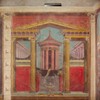
Which sculpture demonstrates an innovation that would finally break the Egyptian hold on Greek style and send the Greeks off on their own path of discovery?
- The Kritios boy belongs to the Late Archaic period and is considered the precursor to the later classical sculptures of athletes
- accurate rendering of the lips and the austere expression that characterized the transitional, or “Severe” period (No Archaic smile)
- a complete understanding of how the different parts of the body act as a system.
- The statue moves away from the rigid and stiff pose of the Archaic style.
- Kritios Boy presents a more relaxed and naturalistic pose known as contrapposto (counter balancing)
Etruscan artists excelled at producing monumental sculptures made of which material?
- Clay (ex. Apolloof Veii)
- Bronze (ex.Capitoline Wolf)

How was the Parthenon’s sense of harmony and balance created by its architects?
- Mathematical ratio was used (x=2y+1 or4:9)
- Optical illusions created harmony
- Every stone had to be cut according to distorted specifications
- Optical Illusions used to fake perfection:
- straight columns look thinner in the middle; to counter this they made columns thicker in the middle.
- Stylobate (continuous base supporting columns) curves upward in the center on all sides- also true for entablature to prevent saging in center
- Outward Columns also lean inward slightly
- Columns at corners have a diagonal inclination and are 2 inches thicker than the rest- thicker because surrounded by light which would make them appear thinner than rest.
- Corner columns closer togther, middle columns farther apart
The exterior of the Colosseum is adorned with what type of columns?
- Tuscan on the lowest story
- Ionic on the middle story
- Corinthian on the uppermost story
Discuss the function and use of the Roman catacombs.
- vast subterranean networks of (galleries) passagewaysand chambers designed as cemetaries for burrying Christians and Jews and possibly others
- Underground cemetary
- Catacombs means “in the hollows”
- Christianity was illegal- so christians met in the catacombs to worship and disscuss Jesus
Explain the cause of the rift created between the eastern and western portions of the Christian church in 726 CE.
- also called the Great Schism and the Schism of 1054
- happened ~ 700 CE
- the break of communionbetween what are now the Roman Catholic Church and Eastern Orthodox churches
- Church/Imperial concerns over christians worshipping icons/images; this violated the2nd commandment
- Imperial (iconoclast) ban on holy images lead to Iconoclasm (breaking of images).
- Emperor Leo III banned images
- Eastern Roman Empire asked the Western (Roman catholic church) to do the same.
- Roman catholics (Iconophiles) refused to do so stating that images helped them to convert and teach illiterate peoples around them
- Dissagreement caused a schism between eastern orthodox and western roman catholic that would last for over a century.
What are the functions of Squinches and Pendentives?
- Pendentives and squinches are architectural supports that bridge the difference between a square room and the curved dome that rises above it.
- A squinch is a wedge that fits on the top corners of a square space. At the point where the dome’s bottom edge meets the room’s upper horizontal edges, four triangular-like wedges (often similar to a small bridge or arch) are placed in the corners. The four squinches turn the square into an octagon, which enables a dome to rest on top of it; tended to have a blocky, chunky appearance.
- A pendentive also supports a dome but it’s more complicated, using geometry to create a series of curving and arched supports.Architects used four pendentives on the upper corners of a room, where they arched inward to meet the dome’s circular base. One of the earliest examples of pendentives can be found in Hagia Sophia, a structure in Istanbul, Turkey that was built around 537 AD.



